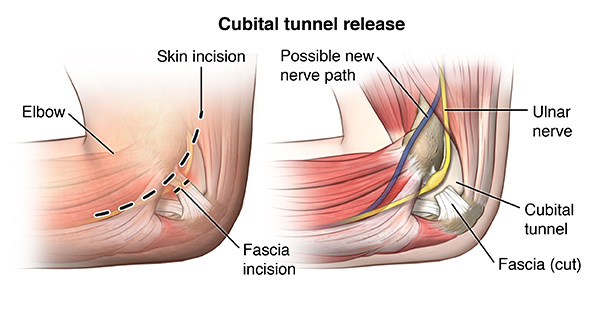Ulnar Nerve Decompression at the Elbow
Introduction
The ulnar nerve is one of the 3 main nerves in the arm. At the elbow, it travels under a bony protuberance on the inside of the elbow (medial epicondyle) and passes under the muscles of the forearm. It continues into the hand on the side of the palm, towards the little finger. The ulnar nerve helps in control most of the hand muscles which carry out fine movements as well as some bigger forearm muscles which help in making a strong grip.
The ulnar nerve can be compressed at several places which results in nerve entrapment. Compression of the nerve occurs most commonly against the medial epicondyle and is called cubital tunnel syndrome. This is commonly caused by direct injury or excessive pressure placed on the elbow
Signs & Symptoms
- Numbness and tingling in the ring and little fingers
- Pain and burning in the inside of the forearm and may radiate up the hand and wrist
- Decreased sensation and weakness in the hand with diminished grip strength
- Worsening of symptoms at night
- Progressive loss of the hand’s ability to move
- Drawing back (clawing) of the fourth and fifth digits of your hand
Diagnosis
Your doctor will perform a detailed medical history and physical examination. Further tests may be ordered including an X-ray to view your wrist bones; blood tests to rule out underlying medical conditions such as diabetes, arthritis and thyroid problems, and electrodiagnostic testing (nerve conduction studies & EMG) to assess the speed and degree of electrical activity in your nerves and muscles.
Surgical Procedure

Ulnar nerve transposition is performed under general or regional anaesthesia. Your surgeon will make a small incision around the medial epicondyle and locate the ulnar nerve. The ulnar nerve will be decompressed along its length into the arm and forearm to ensure any compression is released.
In some cases, a transposition of the ulnar nerve is required. Your surgeon will move the ulnar nerve from under the medial epicondyle and reposition it in front of the medial epicondyle (anterior transposition). The nerve can be placed on top of the muscle, under the skin and fat (subcutaneous transposition), under the muscle (sub muscular transposition) or within the muscle (intramuscular transposition). The incision will then be sutured.
Risks and Complications
As with any surgical procedure, ulnar nerve decompression/transposition involves certain risks and complications. Some of the complications that may occur include:
- Nerve injury
- Failure to completely decompress the ulnar nerve
- Infection
- Thrombophlebitis (inflammation of veins)




